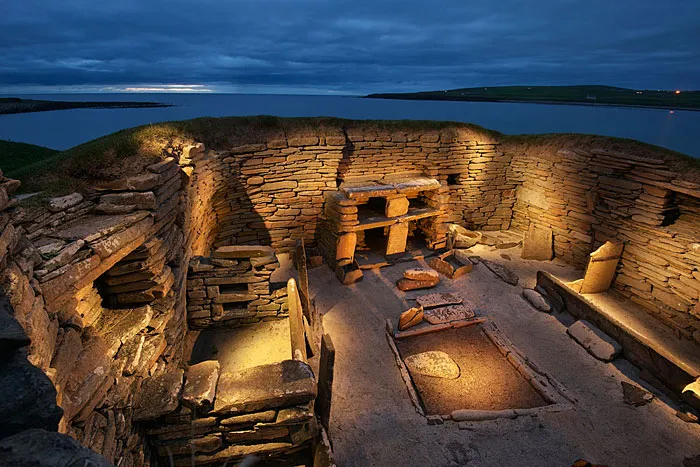


Discovery and Initial Excavation
1850:
- Skara Brae was discovered after a severe storm hit the Bay of Skaill, uncovering part of the ancient settlement. The storm removed the sand and earth that had buried the site, revealing stone structures.
1861-1924:
- Initial interest led to some informal excavations. However, it wasn’t until the 1920s that more systematic excavations began.
1927-1930:
- Archaeologist V. Gordon Childe led the first scientific excavations. Childe’s work revealed the extent and significance of the site, uncovering eight well-preserved stone houses.



Dating and Construction
Circa 3180 BC – 2500 BC:
- Radiocarbon dating indicates that Skara Brae was occupied during this period, making it one of the oldest and best-preserved Neolithic sites in Europe.
- The settlement consists of houses built into midden heaps, providing insulation and stability. The use of stone for construction reflects the scarcity of timber in Orkney.
Architecture and Layout
- Clustered Houses: The village contains ten houses arranged in a tight cluster, connected by a series of low, covered passageways.
- House Layout: Each house had a consistent design, featuring:
- Central Hearth: A stone hearth in the middle of the room used for cooking and heating.
- Stone Beds: Stone-built bed frames placed against the walls.
- Stone Dressers: Stone dressers or shelves opposite the entrance, are used for displaying valuable items.
- Infrastructure: The settlement had an advanced drainage system, including a form of indoor plumbing and toilets.

Daily Life and Culture
- Agriculture and Diet:
- Residents practised mixed farming, growing barley and wheat.
- They kept livestock, including cattle and sheep, and supplemented their diet with fishing and hunting.
- Artefacts and Tools:
- Numerous artefacts have been found, including pottery, stone tools, and bone implements.
- Decorative items such as beads and carved stones indicate a rich cultural life.
- Social Structure:
- The uniformity of the houses suggests a relatively egalitarian society without significant social stratification.
- Artefacts like gaming dice and carved objects imply leisure activities and a cultural appreciation for art and play.
Abandonment

Circa 2500 BC:
- The settlement was abandoned around this time, but the exact reasons remain unclear. Theories include:
- Environmental Changes: Coastal erosion or climatic changes may have made the site less habitable.
- Social Factors: Shifts in social or economic conditions could have led to the relocation of the community.
- Catastrophic Events: Some speculate that a significant storm or other natural disaster forced the abandonment.
Rediscovery and Modern Excavation
20th Century:
- After Childe’s initial work, further excavations continued throughout the 20th century, improving understanding of the site.
- Excavations in the late 1970s and 1980s provided more detailed information about the settlement’s layout and the lives of its inhabitants.
Significance
- UNESCO World Heritage Site:
- Skara Brae is part of the Heart of Neolithic Orkney, designated as a UNESCO World Heritage Site in 1999.
- This designation includes other significant Neolithic sites such as Maeshowe, the Stones of Stenness, and the Ring of Brodgar.
- Archaeological Importance:
- Skara Brae offers invaluable insights into Neolithic life, architecture, and society.
- The preservation of the site, with its well-built stone structures and artefacts, provides a detailed picture of life 5,000 years ago.

Preservation and Tourism
- Management:
- Today, Skara Brae is managed by Historic Environment Scotland, ensuring its preservation and accessibility.
- Visitor Experience:
- The site is a major tourist attraction, with a visitor centre and museum that offer educational exhibits about the Neolithic period.
- Visitors can explore the ancient houses, walk through the passageways, and learn about the daily lives of Skara Brae’s inhabitants.
Legacy
- Educational Value:
- Skara Brae is an essential educational resource, offering insights into prehistoric human life, societal organization, and technological advancement.
- Cultural Impact:
- The site has inspired numerous studies, books, and documentaries, highlighting its significance in understanding human history.
- Ongoing Research:
- Archaeological research at Skara Brae continues, with new discoveries and interpretations shedding light on the ancient past.



Skara Brae remains a testament to the ingenuity and resilience of its Neolithic inhabitants, providing a window into a world that existed 5,000 years ago. Its preservation and ongoing study offer valuable lessons about human adaptation and the enduring legacy of our prehistoric ancestors.


